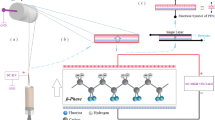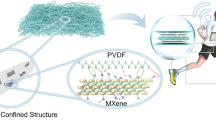Abstract
Electrical stimulation is critical for axonal connection, which can stimulate axonal migration and deformation to promote axonal growth in the nervous system. Netrin-1, an axonal guidance cue, can also promote axonal guidance growth, but the molecular mechanism of axonal guidance growth under indirect electric stimulation is still unknown. We investigated the molecular mechanism of axonal guidance growth under piezoelectric ceramic lead zirconate titanate (PZT) stimulation in the primary cultured cortical neurons. PZT induced marked axonal elongation. Moreover, PZT activated the excitatory postsynaptic currents (EPSCs) by increasing the frequency and amplitude of EPSCs of the cortical neurons in patch clamp assay. PZT downregulated the expression of Netrin-1 and its receptor Deleted in Colorectal Cancer (DCC). Rho GTPase signaling is involved in interactions of Netrin-1 and DCC. PZT activated RhoA. Dramatic decrease of Cdc42 and Rac1 was also observed after PZT treatment. RhoA inhibitor Clostridium botulinum C3 exoenzyme (C3-Exo) prevented the PZT-induced downregulation of Netrin-1 and DCC. We suggest that PZT can promote axonal guidance growth by downregulation of Netrin-1 and DCC to mediate axonal repulsive responses via the Rho GTPase signaling pathway. Obviously, piezoelectric materials may provide a new approach for axonal recovery and be beneficial for clinical therapy in the future.




Similar content being viewed by others
References
Barallobre MJ, Pascual M, Del Rio JA, Soriano E (2005) The Netrin family of guidance factors: emphasis on Netrin-1 signalling. Brain Res Brain Res Rev 49:22–47
Bradford D, Cole SJ, Cooper HM (2009) Netrin-1: diversity in development. Int J Biochem Cell Biol 41:487–493
Brankatschk M, Dickson BJ (2006) Netrins guide Drosophila commissural axons at short range. Nat Neurosci 9:188–194
Brown JA, Tuszynski JA (1999) A review of the ferroelectric model of microtubules. Ferroelectrics 220:141–156
Ciofani G, Danti S, D'Alessandro D, Ricotti L, Moscato S, Bertoni G, Falqui A, Berrettini S, Petrini M, Mattoli V, Menciassi A (2010) Enhancement of neurite outgrowth in neuronal-like cells following boron nitride nanotube-mediated stimulation. ACS Nano 4:6267–6277
Cirulli V, Yebra M (2007) Netrins: beyond the brain. Nat Rev Mol Cell Biol 8:296–306
Deiner MS, Sretavan DW (1999) Altered midline axon pathways and ectopic neurons in the developing hypothalamus of netrin-1- and DCC-deficient mice. J Neurosci 19:9900–9912
Giger RJ, Kolodkin AL (2001) Silencing the siren: guidance cue hierarchies at the CNS midline. Cell 105:1–4
Hong K, Hinck L, Nishiyama M, Poo MM, Tessier-Lavigne M, Stein E (1999) A ligand-gated association between cytoplasmic domains of UNC5 and DCC family receptors converts netrin-induced growth cone attraction to repulsion. Cell 97:927–941
Huang JH, Zager EL, Zhang J, Groff RF, Pfister BJ, Cohen AS, Grady MS, Maloney-Wilensky E, Smith DH (2008) Harvested human neurons engineered as live nervous tissue constructs: implications for transplantation. Laboratory investigation. J Neurosurg 108:343–347
Kao YY, Cheng TJ, Yang DM, Wang CT, Chiung YM, Liu PS (2012) Demonstration of an olfactory bulb-brain translocation pathway for ZnO nanoparticles in rodent cells in vitro and in vivo. J Mol Neurosci 48:464–471
Kennedy TE (2000) Cellular mechanisms of netrin function: long-range and short-range actions. Biochem Cell Biol 78:569–575
Kim TH, Lee HK, Seo IA, Bae HR, Suh DJ, Wu J, Rao Y, Hwang KG, Park HT (2005) Netrin induces down-regulation of its receptor, Deleted in Colorectal Cancer, through the ubiquitin–proteasome pathway in the embryonic cortical neuron. J Neurochem 95:1–8
Larson PJ, Towe BC (2011) Miniature ultrasonically powered wireless nerve cuff stimulator. In: Proceedings of the 5th International IEEE EMBS Conference on Neural Engineering, Cancun, 27 April to 1 May 2011, pp. 265–268
Li X, Saint-Cyr-Proulx E, Aktories K, Lamarche-Vane N (2002) Rac1 and Cdc42 but not RhoA or Rho kinase activities are required for neurite outgrowth induced by the Netrin-1 receptor DCC (deleted in colorectal cancer) in N1E-115 neuroblastoma cells. J Biol Chem 277:15207–15214
Li X, Gao X, Liu G, Xiong W, Wu J, Rao Y (2008) Netrin signal transduction and the guanine nucleotide exchange factor DOCK180 in attractive signaling. Nat Neurosci 11:28–35
Lipton ML, Gellella E, Lo C, Gold T, Ardekani BA, Shifteh K, Bello JA, Branch CA (2008) Multifocal white matter ultrastructural abnormalities in mild traumatic brain injury with cognitive disability: a voxel-wise analysis of diffusion tensor imaging. J Neurotrauma 25:1335–1342
Liu G, Beggs H, Jurgensen C, Park HT, Tang H, Gorski J, Jones KR, Reichardt LF, Wu J, Rao Y (2004) Netrin requires focal adhesion kinase and Src family kinases for axon outgrowth and attraction. Nat Neurosci 7:1222–1232
Liu ML, Wen JQ, Fan YB (2011) Potential protection of green tea polyphenols against 1800 MHz electromagnetic radiation-induced injury on rat cortical neurons. Neurotox Res 20:270–276
Metin C, Deleglise D, Serafini T, Kennedy TE, Tessier-Lavigne M (1997) A role for netrin-1 in the guidance of cortical efferents. Development 124:5063–5074
Moon C, Kim H, Ahn M, Jin JK, Wang H, Matsumoto Y, Shin T (2006) Enhanced expression of netrin-1 protein in the sciatic nerves of Lewis rats with experimental autoimmune neuritis: possible role of the netrin-1/DCC binding pathway in an autoimmune PNS disorder. J Neuroimmunol 172:66–72
Seil FJ (1989) Tissue culture studies of neural plasticity. Restor Neurol Neurosci 1:1–11
Seil JT, Webster TJ (2010) Electrically active nanomaterials as improved neural tissue regeneration scaffolds. Wiley Interdiscip Rev Nanomed Nanobiotechnol 2:635–647
Serafini T, Kennedy TE, Galko MJ, Mirzayan C, Jessell TM, Tessier-Lavigne M (1994) The netrins define a family of axon outgrowth-promoting proteins homologous to C. elegans UNC-6. Cell 78:409–424
Shen Y, Yu LC (2008) Potential protection of curcumin against hypoxia-induced decreases in beta-III tubulin content in rat prefrontal cortical neurons. Neurochem Res 33:2112–2117
Shim SO, Cafferty WB, Schmidt EC, Kim BG, Fujisawa H, Strittmatter SM (2012) Plexin A2 limits recovery from corticospinal axotomy by mediating oligodendrocyte-derived Sema6A growth inhibition. Mol Cell Neurosci 50:193–200
Shirasaki R, Katsumata R, Murakami F (1998) Change in chemoattractant responsiveness of developing axons at an intermediate target. Science 279:105–107
Acknowledgments
This work was sponsored by funds from NSFC Research Grant (no. 31100666). The authors would like to thank Dr. Colin McClean for his help in language editing.
Author information
Authors and Affiliations
Corresponding author
Additional information
Jianqiang Wen and Meili Liu contributed equally to this work.
Rights and permissions
About this article
Cite this article
Wen, J., Liu, M. Piezoelectric Ceramic (PZT) Modulates Axonal Guidance Growth of Rat Cortical Neurons via RhoA, Rac1, and Cdc42 Pathways. J Mol Neurosci 52, 323–330 (2014). https://doi.org/10.1007/s12031-013-0149-7
Received:
Accepted:
Published:
Issue Date:
DOI: https://doi.org/10.1007/s12031-013-0149-7




